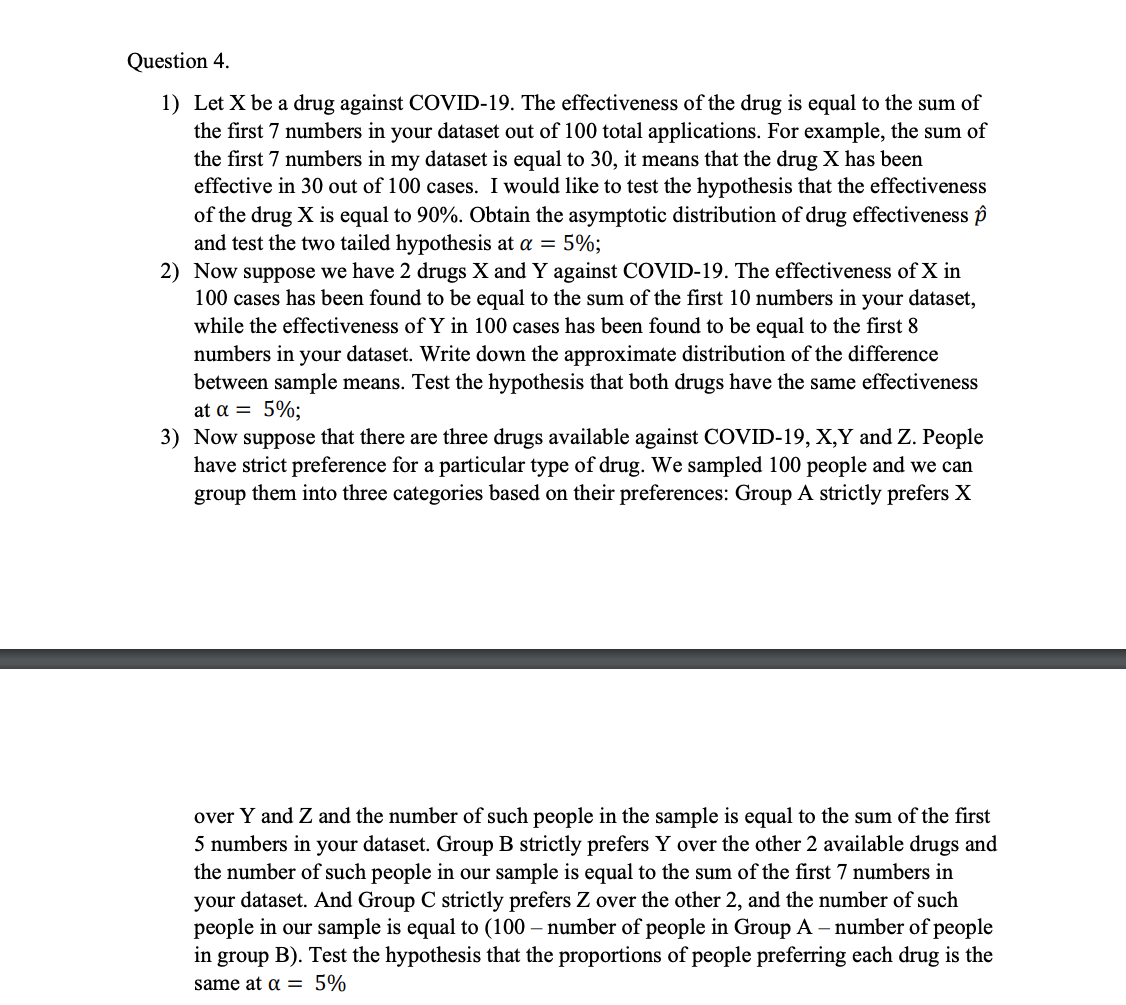Let X be a drug against COVID-19. The effectiveness of the drug is equal to the sum of the first 7 numbers in your dataset out of 100 total applications. For example, the sum of the first 7 numbers in my dataset is equal to 30, it means that the drug X has been effective in 30 out of 100 cases. I would like to test the hypothesis that the effectiveness
Let X be a drug against COVID-19. The effectiveness of the drug is equal to the sum of the first 7 numbers in your dataset out of 100 total applications. For example, the sum of the first 7 numbers in my dataset is equal to 30, it means that the drug X has been effective in 30 out of 100 cases. I would like to test the hypothesis that the effectiveness
Linear Algebra: A Modern Introduction
4th Edition
ISBN:9781285463247
Author:David Poole
Publisher:David Poole
Chapter2: Systems Of Linear Equations
Section2.4: Applications
Problem 1EQ: 1. Suppose that, in Example 2.27, 400 units of food A, 600 units of B, and 600 units of C are placed...
Related questions
Topic Video
Question
My data sets were given picture which I sent

Transcribed Image Text:Question 4.
1) Let X be a drug against COVID-19. The effectiveness of the drug is equal to the sum of
the first 7 numbers in your dataset out of 100 total applications. For example, the sum of
the first 7 numbers in my dataset is equal to 30, it means that the drug X has been
effective in 30 out of 100 cases. I would like to test the hypothesis that the effectiveness
of the drug X is equal to 90%. Obtain the asymptotic distribution of drug effectiveness p
and test the two tailed hypothesis at a = 5%;
2) Now suppose we have 2 drugs X and Y against COVID-19. The effectiveness of X in
100 cases has been found to be equal to the sum of the first 10 numbers in your dataset,
while the effectiveness of Y in 100 cases has been found to be equal to the first 8
numbers in your dataset. Write down the approximate distribution of the difference
between sample means. Test the hypothesis that both drugs have the same effectiveness
at a = 5%;
3) Now suppose that there are three drugs available against COVID-19, X,Y and Z. People
have strict preference for a particular type of drug. We sampled 100 people and we can
group them into three categories based on their preferences: Group A strictly prefers X
over Y and Z and the number of such people in the sample is equal to the sum of the first
5 numbers in your dataset. Group B strictly prefers Y over the other 2 available drugs and
the number of such people in our sample is equal to the sum of the first 7 numbers in
your dataset. And Group C strictly prefers Z over the other 2, and the number of such
people in our sample is equal to (100 – number of people in Group A – number of people
in group B). Test the hypothesis that the proportions of people preferring each drug is the
same at a = 5%
![[65747668 4 2676234674 664 664 85 6 4 6]](/v2/_next/image?url=https%3A%2F%2Fcontent.bartleby.com%2Fqna-images%2Fquestion%2Fe8165b54-1e9b-4b79-aa5b-d063ee0876a3%2F661b9b9e-8e36-4f33-a453-682772a148ca%2F9ix77ll_processed.png&w=3840&q=75)
Transcribed Image Text:[65747668 4 2676234674 664 664 85 6 4 6]
Expert Solution
This question has been solved!
Explore an expertly crafted, step-by-step solution for a thorough understanding of key concepts.
Step by step
Solved in 2 steps with 2 images

Knowledge Booster
Learn more about
Need a deep-dive on the concept behind this application? Look no further. Learn more about this topic, statistics and related others by exploring similar questions and additional content below.Recommended textbooks for you

Linear Algebra: A Modern Introduction
Algebra
ISBN:
9781285463247
Author:
David Poole
Publisher:
Cengage Learning

Algebra & Trigonometry with Analytic Geometry
Algebra
ISBN:
9781133382119
Author:
Swokowski
Publisher:
Cengage

Trigonometry (MindTap Course List)
Trigonometry
ISBN:
9781337278461
Author:
Ron Larson
Publisher:
Cengage Learning

Linear Algebra: A Modern Introduction
Algebra
ISBN:
9781285463247
Author:
David Poole
Publisher:
Cengage Learning

Algebra & Trigonometry with Analytic Geometry
Algebra
ISBN:
9781133382119
Author:
Swokowski
Publisher:
Cengage

Trigonometry (MindTap Course List)
Trigonometry
ISBN:
9781337278461
Author:
Ron Larson
Publisher:
Cengage Learning

Algebra for College Students
Algebra
ISBN:
9781285195780
Author:
Jerome E. Kaufmann, Karen L. Schwitters
Publisher:
Cengage Learning

Intermediate Algebra
Algebra
ISBN:
9781285195728
Author:
Jerome E. Kaufmann, Karen L. Schwitters
Publisher:
Cengage Learning